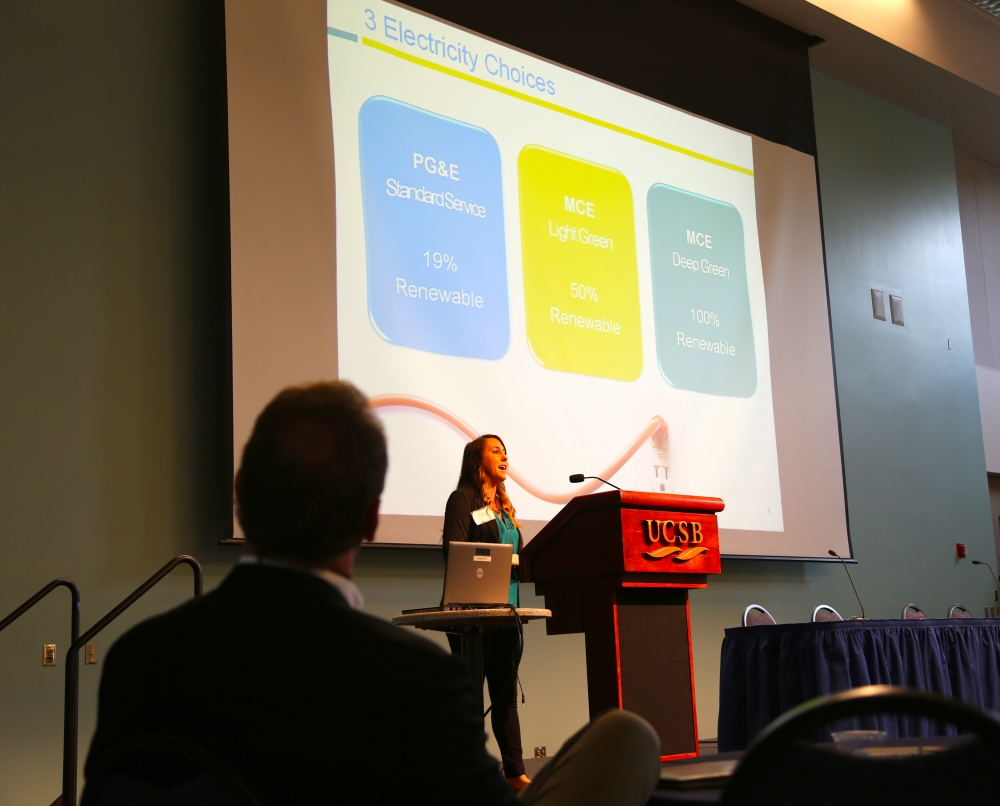
Central Coast Sustainability Summit Points the Way to New Projects

The overarching motif of the Third Annual Central Coast Sustainability Summit is building — not edifices per se, rather the foundations for promoting sustainable practices in Santa Barbara County and beyond. Held at UC Santa Barbara's Corwin Pavilion, speakers throughout the day shared their firsthand experience in taking "Action Today for Tomorrow," the tagline for conference host UCSB Sustainability.
The nuts and bolts of implementing sustainable practices on the Central Coast were discussed in relation to community renewable energy options; buy-local initiatives; new paradigms of volunteerism; energy-saving improvements; environmentally preferable purchasing; and investing in youth and career training for the future.
"It's exciting to see how much energy and how many people are geared up toward action coming out of today," said conference organizer Katie Maynard, who is also the sustainability coordinator for UCSB.
With the goal of sharing best practices and building collaborations to address complex environmental issues, the event brought together key stakeholders from local government agencies, chambers of commerce, nonprofit organizations, campuses, utility companies and private industry. The summit focused on four themes: economic development; product stewardship and extended producer responsibility; renewable energy; and cross-agency volunteer management.
Said opening speaker Michael Holliday: "Economic development as a theme sits at the intersection of the environmental movement and the business community." Holliday, an architect, entrepreneur and business leader, sees Santa Barbara's destiny closely tied to its role in leading the way forward in environmental stewardship.
Keynote speaker Jamie Tuckey, communications director of the Marin Energy Authority, talked about her company's ground-breaking creation of California's first community choice aggregation (CCA) program. CCA is a system adopted into law that allows cities and counties to aggregate the buying power of individual customers within a defined jurisdiction in order to secure alternative energy supply contracts.
Marin's CCA, Marin Clean Energy, which goes by its initials, MCE, offers two options: Light Green with 53 percent renewable energy and Deep Green, which is 100 percent renewable wind energy. The costs are competitive with PG&E, the local utility company that owns the transmission lines. Electricity users are automatically enrolled in MCE's Light Green program and have to opt up to Deep Green or opt out to have PG&E as their sole supplier.
The subsequent session on CCAs was well-attended by an audience ready to take the first steps toward implementing such a program in Santa Barbara. "I already have solar panels on my house," said attendee Laura Francis, education coordinator at the Channel Islands National Marine Sanctuary. "But I'm ready to work to make this happen."
Scott Cassell, another keynote speaker, is executive director of the Boston-based Product Stewardship Institute (PSI). He has been instrumental in the development and passage of extended producer responsibility (EPR) legislation in more than 30 states. He discussed PSI's role as a national nonprofit organization focused on developing post-consumer product waste management solutions with an emphasis on producer responsibility.
When the PSI was established in 2000, there were only a handful of EPR laws in place. This year alone, nine EPR bills became law or were passed in state or local legislatures. Today, there are 76 EPR laws in 32 states, covering such items as paint, batteries, thermostats, electronics, fluorescent lamps, mattresses and pharmaceuticals.
According to Cassell, California plays a key role in the national movement toward sustainable product manufacture and end-of-life product management. He urged the audience to take action by putting EPR procurement specifications in place and writing letters of support for EPR legislation, especially California State Senate Bill 727, which would establish a pharmaceutical collection program.
"You've got the power," Cassell said. "It takes a whole lot of people to make this work, but we all have the same goal."
Speaker Erik Talkin, chief executive officer of the Santa Barbara Foodbank, explained the profound effect of his organization's change in perspective. Rather than focus on hunger, the food bank now aims to transform the health of the county by promoting good nutrition. Along with that change came a parallel shift in its volunteer model, which now seeks invested community leaders as volunteers.
Two UCSB alumni were participants in a panel discussion on "Achieving Wide-Scale Adoption of Energy Efficiency and Renewable Energy." Allen Associates' Bryan Henson talked about the importance of educating the public about the real costs of green building. "We have an historic opportunity," Henson said. "California leads the way on the big picture." Alumnus Jim Dewey, facilities and energy manager for the city of Santa Barbara, shared ideas for promoting renewable energy projects.
Angie Hacker, panel moderator and program manager and developer of Santa Barbara County's emPower program, noted that California is in the forefront of innovative implementation. "We have a tough job ahead of us," she said. "What we're trying to do is pretty big and pretty important, but we're making strides."
The message that echoed repeatedly throughout the day, although in different guises, was that small projects have far-reaching results. An example of this is Santa Monica's fire department, which gave up five-gallon water bottles in favor of directly plumbed filtered water, saving $18,000. Another program implemented by the trail-blazing city of Santa Monica is its Buy Local campaign, which generates more in sales tax revenue — $47 million — than either the transit occupancy tax or property tax.
Maynard saw many participants making one-on-one connections and discussing smaller projects leading up to the bigger collaborations that were the focus of the summit. "I'm really excited to see all of these new ideas growing organically out of the networking that came out of today," she said.



